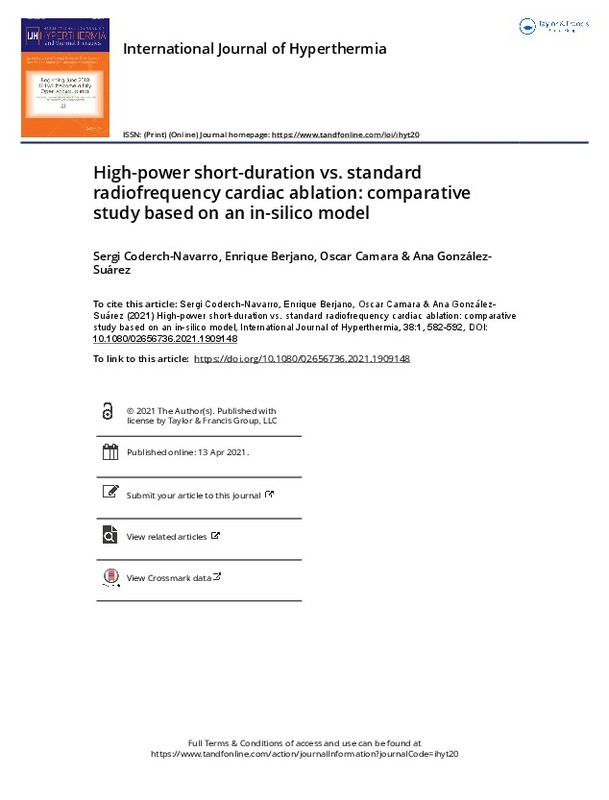JavaScript is disabled for your browser. Some features of this site may not work without it.
Buscar en RiuNet
Listar
Mi cuenta
Estadísticas
Ayuda RiuNet
Admin. UPV
High-power short-duration vs. standard radiofrequency cardiac ablation: comparative study based on an in-silico model
Mostrar el registro sencillo del ítem
Ficheros en el ítem
| dc.contributor.author | Coderch-Navarro, Sergi
|
es_ES |
| dc.contributor.author | Berjano, Enrique
|
es_ES |
| dc.contributor.author | Cámara, Óscar
|
es_ES |
| dc.contributor.author | González-Suárez, Ana
|
es_ES |
| dc.date.accessioned | 2021-11-05T14:11:39Z | |
| dc.date.available | 2021-11-05T14:11:39Z | |
| dc.date.issued | 2021-01-01 | es_ES |
| dc.identifier.issn | 0265-6736 | es_ES |
| dc.identifier.uri | http://hdl.handle.net/10251/176469 | |
| dc.description.abstract | [EN] Purpose While the standard setting during radiofrequency catheter ablation (RFCA) consists of applying low power for long times, a new setting based on high power and short duration (HPSD) has recently been suggested as safer and more effective. Our aim was to compare the electrical and thermal performance of standard vs. HPSD settings, especially to assess the effect of the catheter orientation. Methods A 3D computational model was built based on a coupled electric-thermal-flow problem. Standard (20 W-45 s and 30 W-30 s) and HPSD settings (70 W-7 s and 90 W-4 s) were compared. Since the model only included a cardiac tissue fragment, the power values were adjusted to 80% of the clinical values (15, 23, 53 and 69 W). Three catheter-tissue orientations were considered (90 degrees, 45 degrees and 0 degrees). Thermal lesions were assessed by the Arrhenius equation. Safety was assessed by checking the occurrence of steam pops (100 degrees C in tissue) and thrombus formation (80 degrees C in blood). Results The computed thermal lesions were in close agreement with the experimental data in the literature, in particular with in vivo studies. HPSD created shallower and wider lesions than standard settings, especially with the catheter at 45 degrees. Steam pops occurred earlier with HPSD, regardless of catheter orientation. Conclusion HPSD seems to be more effective in cases that need shallow and extensive lesions, especially when the catheter is at 0 degrees or at 45 degrees, as used in pulmonary vein isolation. | es_ES |
| dc.description.sponsorship | This work was supported by the Spanish Ministerio de Ciencia, Innovacion y Universidades under 'Programa Estatal de IthornDthorni Orientada a los Retos de la Sociedad', Grant No 'RTI2018-094357-B-C21'. | es_ES |
| dc.language | Inglés | es_ES |
| dc.publisher | Taylor & Francis | es_ES |
| dc.relation.ispartof | International Journal of Hyperthermia | es_ES |
| dc.rights | Reconocimiento (by) | es_ES |
| dc.subject | Cardiac ablation | es_ES |
| dc.subject | Computer model | es_ES |
| dc.subject | High-power shortduration settings | es_ES |
| dc.subject | Radiofrequency ablation | es_ES |
| dc.subject | Standard settings | es_ES |
| dc.subject.classification | TECNOLOGIA ELECTRONICA | es_ES |
| dc.title | High-power short-duration vs. standard radiofrequency cardiac ablation: comparative study based on an in-silico model | es_ES |
| dc.type | Artículo | es_ES |
| dc.identifier.doi | 10.1080/02656736.2021.1909148 | es_ES |
| dc.relation.projectID | info:eu-repo/grantAgreement/AEI/Plan Estatal de Investigación Científica y Técnica y de Innovación 2017-2020/RTI2018-094357-B-C21/ES/MODELADO Y EXPERIMENTACION PARA TERAPIAS ABLATIVAS INNOVADORAS/ | es_ES |
| dc.rights.accessRights | Abierto | es_ES |
| dc.contributor.affiliation | Universitat Politècnica de València. Departamento de Ingeniería Electrónica - Departament d'Enginyeria Electrònica | es_ES |
| dc.description.bibliographicCitation | Coderch-Navarro, S.; Berjano, E.; Cámara, Ó.; González-Suárez, A. (2021). High-power short-duration vs. standard radiofrequency cardiac ablation: comparative study based on an in-silico model. International Journal of Hyperthermia. 38(1):582-592. https://doi.org/10.1080/02656736.2021.1909148 | es_ES |
| dc.description.accrualMethod | S | es_ES |
| dc.relation.publisherversion | https://doi.org/10.1080/02656736.2021.1909148 | es_ES |
| dc.description.upvformatpinicio | 582 | es_ES |
| dc.description.upvformatpfin | 592 | es_ES |
| dc.type.version | info:eu-repo/semantics/publishedVersion | es_ES |
| dc.description.volume | 38 | es_ES |
| dc.description.issue | 1 | es_ES |
| dc.identifier.pmid | 33847211 | es_ES |
| dc.relation.pasarela | S\431400 | es_ES |
| dc.contributor.funder | AGENCIA ESTATAL DE INVESTIGACION | es_ES |








